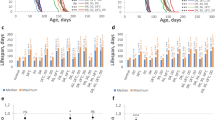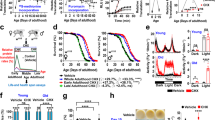Abstract
Many extracellular signals are transmitted to the interior of the cell by receptors with seven membrane-spanning helices that trigger their effects by means of heterotrimeric guanine-nucleotide-binding regulatory proteins (G proteins)1,2,3,4. These G-protein-coupled receptors (GPCRs) control various physiological functions in evolution from pheromone-induced mating in yeast to cognition in humans5,6. The potential role of the G-protein signalling system in the control of animal ageing has been highlighted by the genetic revelation that mutation of a GPCR encoded by methuselah extends the lifespan of adult Drosophila flies7. How methuselah functions in controlling ageing is not clear. A first essential step towards the understanding of methuselah function is to determine the ligands of Methuselah. Here we report the identification and characterization of two endogenous peptide ligands of Methuselah, designated Stunted A and B. Flies with mutations in the gene encoding these ligands show an increase in lifespan and resistance to oxidative stress. We conclude that the Stunted–Methuselah system is involved in the control of animal ageing.
This is a preview of subscription content, access via your institution
Access options
Subscribe to this journal
Receive 12 print issues and online access
$209.00 per year
only $17.42 per issue
Buy this article
- Purchase on Springer Link
- Instant access to full article PDF
Prices may be subject to local taxes which are calculated during checkout




Similar content being viewed by others
References
Gilman, A.G. G proteins: transducers of receptor-generated signals. Annu. Rev. Biochem. 56, 615–649 (1987).
Bourne, H.R., Sanders, D.A. & McCormick, F. The GTPase superfamily: a conserved switch for diverse cell functions. Nature 348, 125–132 (1990).
Dohlman, H.G., Thorner, J., Caron, M.G. & Lefkowitz, R.J. Model systems for the study of seven-transmembrane-segment receptors. Annu. Rev. Biochem. 60, 653–688 (1991).
Simon, M.I., Strathmann, M.P. & Gautam, N. Diversity of G proteins in signal transduction. Science 252, 802–808 (1991).
Herskowitz, I. MAP kinase pathways in yeast: for mating and more. Cell 80, 187–197 (1995).
Morris, A.J. & Malbon, C.C. Physiological regulation of G protein-linked signaling. Physiol. Rev. 79, 1373–1430 (1999).
Lin, Y.J., Seroude, L. & Benzer, S. Extended life-span and stress resistance in the Drosophila mutant methuselah. Science 282, 943–946 (1998).
Tu, Q. et al. Cloning, characterization and mapping of the human ATP5E gene, identification of pseudogene ATP5EP1, and definition of the ATP5E motif. Biochem. J. 347, 17–21 (2000).
Boyer, P.D. The ATP synthase—a splendid molecular machine. Annu. Rev. Biochem. 66, 717–749 (1997).
Lai-Zhang, J., Xiao, Y. & Mueller, D.M. Epistatic interactions of deletion mutants in the genes encoding the F1-ATPase in yeast Saccharomyces cerevisiae. EMBO J. 18, 58–64 (1999).
Moser, T.L. et al. Angiostatin binds ATP synthase on the surface of human endothelial cells. Proc. Natl Acad. Sci. USA 96, 2811–2816 (1999).
Moser, T.L. et al. Endothelial cell surface F1-F0 ATP synthase is active in ATP synthesis and is inhibited by angiostatin. Proc. Natl Acad. Sci. USA 98, 6656–6661 (2001).
Martinez, L.O. et al. Ectopic β-chain of ATP synthase is an apolipoprotein A-I receptor in hepatic HDL endocytosis. Nature 421, 75–79 (2003).
Beisiegel, U. et al. Apolipoprotein E-binding proteins isolated from dog and human liver. Arteriosclerosis 8, 288–297 (1988).
Chang, S.Y., Park, S.G., Kim, S. & Kang, C.Y. Interaction of the C-terminal domain of p43 and the α subunit of ATP synthase. Its functional implication in endothelial cell proliferation. J. Biol. Chem. 277, 8388–8394 (2002).
Das, B., Mondragon, M.O., Sadeghian, M., Hatcher, V.B. & Norin, A.J. A novel ligand in lymphocyte-mediated cytotoxicity: expression of the β subunit of H+ transporting ATP synthase on the surface of tumor cell lines. J. Exp. Med. 180, 273–281 (1994).
Park, Y., Kim, Y.J. & Adams, M.E. Identification of G protein-coupled receptors for Drosophila PRXamide peptides, CCAP, corazonin, and AKH supports a theory of ligand–receptor coevolution. Proc. Natl Acad. Sci. USA 99, 11423–11428 (2002).
Katzen, A.L. & Bishop, J.M. myb provides an essential function during Drosophila development. Proc. Natl Acad. Sci. USA 93, 13955–13960 (1996).
Dillin, A. et al. Rates of behavior and aging specified by mitochondrial function during development. Science 298, 2398–2401 (2002).
Simon, A.F., Shih, C., Mack, A. & Benzer, S. Steroid control of longevity in Drosophila melanogaster. Science 299, 1407–1410 (2003).
Beckman, K.B. & Ames, B.N. The free radical theory of aging matures. Physiol. Rev. 78, 547–581 (1998).
Sohal, R.S. & Weindruch, R. Oxidative stress, caloric restriction, and aging. Science 273, 59–63 (1996).
Kane, P.M. Regulation of V-ATPases by reversible disassembly. FEBS Lett. 469, 137–141 (2000).
Wang, X. The expanding role of mitochondria in apoptosis. Genes Dev. 15, 2922–2933 (2001).
Raha, S. & Robinson, B.H. Mitochondria, oxygen free radicals, disease and ageing. Trends Biochem. Sci. 25, 502–508 (2000).
Song, W. et al. Presynaptic regulation of neurotransmission in Drosophila by the G protein-coupled receptor Methuselah. Neuron 36, 105–119 (2002).
Acknowledgements
We thank M. Young in whose laboratory the fly genetic work was done; T. Lieber and S. Kidd for advice and help; A. Katzen for the sunEM67 strain and its parental and rescuing fly strains; T. Kidd and D. Ish-Horowicz for the sunY6 strain and its parental fly strains; M. Lu and T. Maack for the use of their HPLC instruments; and D. McGarrigle for reading the manuscript. Mass spectrometric analyses and peptide sequencing were provided by the Rockefeller University Protein/DNA Technology Center. This work was supported by grants from the NIH (to X.-Y.H., M.Y. and Y.B.). X.-Y.H. is an Established Investigator of the American Heart Association, a Career Scientist of the Irma T. Hirschl Trust, and a Charles H. Leach Foundation Research Scholar.
Author information
Authors and Affiliations
Corresponding author
Ethics declarations
Competing interests
The authors declare no competing financial interests.
Rights and permissions
About this article
Cite this article
Cvejic, S., Zhu, Z., Felice, S. et al. The endogenous ligand Stunted of the GPCR Methuselah extends lifespan in Drosophila. Nat Cell Biol 6, 540–546 (2004). https://doi.org/10.1038/ncb1133
Received:
Accepted:
Published:
Issue Date:
DOI: https://doi.org/10.1038/ncb1133
This article is cited by
-
G protein-coupled receptors that influence lifespan of human and animal models
Biogerontology (2022)
-
G-protein signaling is required for increasing germline stem cell division frequency in response to mating in Drosophila males
Scientific Reports (2020)
-
Spermine synthase deficiency causes lysosomal dysfunction and oxidative stress in models of Snyder-Robinson syndrome
Nature Communications (2017)
-
Regulation of Drosophila Lifespan by bellwether Promoter Alleles
Scientific Reports (2017)
-
Methuselah/Methuselah-like G protein-coupled receptors constitute an ancient metazoan gene family
Scientific Reports (2016)



